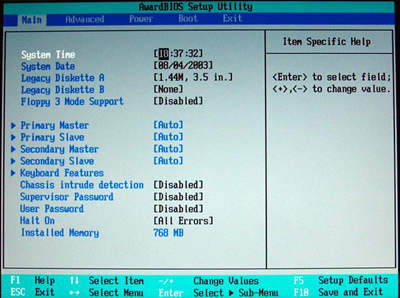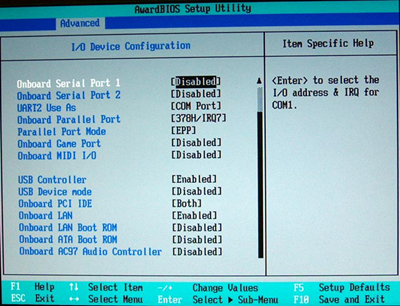ASUS A7V600: Feature-Laden – Value-Priced
by Wesley Fink on August 17, 2003 10:27 PM EST- Posted in
- Motherboards
ASUS A7V600: BIOS and Overclocking

ASUS uses Award BIOS for the A7V600. If you’re familiar with the ASUS implementation of Award and AMI BIOS on their other motherboards, then you will be very comfortable with the BIOS arrangement. It’s a little different than the more common Award arrangement, but all the information and choices are there – they’re just arranged a little differently. Menu choices are across the top and as you navigate across the top choices, different on-screen menus appear. Many of the menus that are stand-alone in traditional Award BIOS are nested under other headings in this BIOS.

The Advanced Features menu is where you will spend most of your time, if you are tweaking for top performance. CPU speed allows the forced selection of 100, 133, 166, or 200 FSB speeds or the fully manual selection of FSB up to 250MHz. If manual is selected, then you can select a multiplier between 5.0 and 22.5 if you wish, and choose the FSB. Since there is no method to fix the AGP/PCI on any KT600 motherboard that we have tested, the CPU speed selection also shows the resulting PCI speed at the chosen FSB. In addition to FSB frequency, you can select memory frequency, voltages for CPU, Memory and AGP, and the System Performance option (Turbo or Optimal available).

Scrolling down in Advanced Features reveals the Chip Configuration option, which is used for setting memory timings, graphics aperture size, and other performance tweaking options.


I/O device configuration is also available in this section of Advanced Features. You will find a complete range of options to enable/disable on-board devices and to adjust their settings.

Under the Power option is the Hardware Monitor sub-menu. ASUS has a tradition of being innovators in options for monitoring the health of your PC, and you will not be disappointed in the options available here. There are readouts for Motherboard and System Temperatures, vCore, and CPU/Chassis/Power Fan speeds. You can also check vCore, and all major power rails. ASUS calls their fan control utility “Q-Fan”, and the options for Q-Fan setup are also found in this section.

There are many available boot devices on the A7V600, so ASUS has included a Boot menu to manage your choices better. You can select the bootable device and set its priorities in this menu. For example, you can set the CD-ROM drive to boot first, and then the Floppy drive, and then the hard drive, and so forth. By using the "+" and "-" keys, you can navigate through the menu of boot choices.
All-in-all, the ASUS BIOS is very complete. The options for overclocking are generally good, with vDIMM settings to 2.85V, vCore to 1.85V, and vAGP to 1.8V. Other KT600 boards have been lacking vAGP settings, but frankly, we find them of limited usefulness in overclocking. They are present on this ASUS. There is no chipset voltage option, which is rare on motherboards, but some BIOS setups also use vAGP to control chipset voltage. We did not test this on the A7V600.
Despite the complete BIOS, there is one glaring omission on the ASUS A7V600 – there is no fixed PCI/AGP Frequency option. In fact, there has not been a PCI/AGP fix option on any KT600 board that we have tested so far. Frankly, this is why the VIA KT600 boards do not overclock well. It is also unforgivable given that all of VIA’s major competitors in all markets – NVIDIA, SiS, and Intel – offer PCI fix options in their current chipsets. This is just another example of why VIA has been losing market share so rapidly in the Athlon market. It is hard to believe that VIA continues to ignore this very critical Enthusiast feature in every chipset they make.
FSB Overclocking Results
The following setup was used on the ASUS A7V600 for FSB overclocking:| Front Side Bus Overclocking Testbed | |
| Processor: | Athlon XP 2500+ (Barton Core) |
| CPU Vcore: | 1.65V (default) |
| Cooling: | Thermalright SK-7 with 80mm Thermaltake Fan |
| Memory: | Two 256MB Corsair 3200LL at SPD |
| Power Supply: | Powmax 350W |
While we could boot into Windows XP at overclocked speeds as high as 220FSB, the highest stable FSB overclocking that we could achieve was 212MHz. Compared to nForce2 Socket A motherboards, this overclocking performance is mediocre. However, compared to other KT600 chipset boards, the A7V600 turns out to be one of the better overclockers. Once again, the reason for the poor overclocking compared to other chipsets is the lack of the option to fix PCI/AGP frequency on the KT600 and ASUS A7V600.










20 Comments
View All Comments
unclefreaky - Tuesday, March 30, 2004 - link
on your asus a7v600 review and testing what where all the bios settings on it. i have one and a radeon 9800pro and it will not run it beeps and no boot i can get to bios but not to windows ive trie everything with no luck and tried other videocards but no luck unless they run at 4x agpim not the only person with this issue and it would help out greatly if you could provide those bois settings we get no reply from asus tech and ati and via havent suggested anything helpful
please help the world and i on this issue
Anonymous User - Monday, September 29, 2003 - link
Somebody asked who uses these motherboards. Well, I've got the Asus A7V600 and until now I haven't seen any motive to feel bad about it. I've read some articles, all of them say the board has a poor performance. 'It's very disappointing' it's said. So, I went to see the benchmarks' results and the difference between the best scores (Nforce 2 based boards included) and the Asus board. I've found it's usually less than 5/6%. Does anybody really notice the difference when running any application or game? What about stability? Isn't there any kind of score for stability? If my system crashes I'll certainly notice. And I haven't had any crash till now, even with my Barton 2500+ running at 2.2 GHz. By the way, in Portugal, Asus A7V600 costs about 30% less than Asus A7N8X Deluxe and about 40% less than MSI KT6 Delta. And the Oscar goes to...sprockkets - Monday, August 25, 2003 - link
Whoops on the post. According to the instructions, you setup raid on the built in bios for it by via.According to Intel, kernel 2.4.20 has built in support for SATA drives, at least for their 865 chipset, but should work fine for VIA.
sprockkets - Monday, August 25, 2003 - link
KF - Friday, August 22, 2003 - link
If Windows can use any HD without a HD controller driver, it is a new one on me. Same for linux. This goes for SCSI as well as IDE. What Windows can do is use a driver that is built in, and some common controllers (like VIA, SIS, Nvidia)emulate a basic old HD controller that goes way back, although to get higher performance the manufacturers provide other drivers. Adaptec, Promise and Highpoint need unique drivers even for their straight HD controllers, let alone the RAID versions, although Windows XP at least has lots of drivers for these. I believe linux is the same. That would make all HD controllers "just typical cheap Taiwanese software based crap."These mobo reviews virtually never check to see if the RAID works even in Windows. No one knows for sure what functions are done in software; people are just guessing or assuming. In general, manufacturers only provide drivers for Windows based systems, and some individual has to write a driver for linux.
Anonymous User - Wednesday, August 20, 2003 - link
SuSE linux like windows should be able to raid it without hardware support, though can't say for sure?Anonymous User - Wednesday, August 20, 2003 - link
Is the Serial RAID hardware or software based? I mean can I configure it via BIOS and install some odd OS like Linux or SCO unix that will just see 1 hard drive and have it work and copy the data to the second drive like real hardware raid? or is this just typical cheap taiwanese software based crap?And also you say its value based but what happens when I pair this up with a geforce video card? wouldn't any possible saving of money disappear into that to the point I would of been better off with a Nforce2 and get the extra performance to boot. When you claim/think about a value based PC's you gotta look at the overall picture of the machine you are building.
Anonymous User - Tuesday, August 19, 2003 - link
Jeff, stop posting, it's already known fact that Gigabyte's nForce2 U400 and other U400 motherboards perform exactly the same as Epox and ASUS's boards. Your request is useless, waste's Anandtech's time, and is getting old quite frankly.Anonymous User - Tuesday, August 19, 2003 - link
#10 has a very good point. I suggest skipping the "tags" instead to make room for some real information. The ones like "Purple, Practical, AND Performance!" feels a little bit like the cheesy article tags over at Toms Hardware. Though theirs are probably unbeatable due to the sometimes apparent language translation factor.Anonymous User - Monday, August 18, 2003 - link
just a minor request - please put the chipset somewhere in the review title like you guys used to - it makes searching through old reviews MUCH easier (ie searching for all KT600 reviews)